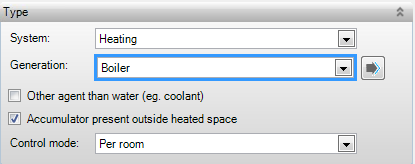

HL BS EPG
This indicates
what is provided by the distribution system: Hot, Cold, or Hot & Cold. In
Hot & Cold, both hot and cold water are transferred to the same emissive
device (change-over) depending on the need. A distribution network is also
required for a heating or cooling coil of an air handling unit, however, for
this a combined Hot & Cold network cannot be specified and two separate
networks (one for hot, and the other for cold) should be specified.
§ Hot-water net distribution network for heating
§ Cold-water net distribution network for cooling
§ Hot- and cold-water net distribution network for both heating and cooling (change-over)
|
|
The choice of the system affects the selection of the distribution in the air handling unit and emissive devices. Example: a hot water network cannot be linked to a cooling coil or to an emissive device for cooling and vice versa. |
[Selection] BS EPG
The generation configuration is chose here from
the generators for heat and/or cold. Only generation configurations can be
selected with generators for Hot, Cold, or Hot and Cold, depending on the
specified system (Hot, Cold, or Hot and Cold respectively). The selection list
is created automatically from all generation resources as specified under the
resource Generation.
EPG
Checking this box
indicates another cooling agent is used other than water, such as a coolant in
multi-split systems. A correction will be made to the distribution efficiency
for heating and/or cooling.
EPG
An accumulator for
the heating system may be located outside the heated space in housing. If this
is the case it can be indicated here and a correction on the distribution
efficiency follows. This option has no effect in case of non-residential
buildings.
HL BS
The control method is characterized by one of the
following three types:
•Per room: In this control mode the
temperature in all rooms can be guaranteed. An example of a control mode per
room is a control with thermostatic valves in all rooms (not in combination with
a room thermostat), for which the supply temperature is constant or being
controlled by means of a heat curve.
The reheat surcharge
for control per room is determined based on the accumulated surfaces in the room
(see Reheat surcharge).
•Room thermostat: In this control mode the
temperature cannot be guaranteed in rooms other than the location of the
thermostat. The room of reference in which the thermostat is located is defined
before the installation concept can be linked to the given distribution network.
Subsequently the system is activated or deactivated based on the difference in
temperature between the specified design temperature and the actual air
temperature in the room of reference. The room of reference of the thermostat
can be set after the geometry definition and the specification of the various
rooms, as specified in Temperature control
rooms.
The reheat surcharge for a given room is determined as a
percentage of the transmission and ventilation in case of room thermostat
control. The reheat surcharge in other rooms is based on this same percentage as
well. The reheat surcharge is determined for each room seperately if the room
has not reheat surcharge.
•Adaptive, or adaptive control, is a
self-learning system which adapts to the results of the previous day(s). The
burner should switch on and off frequently to maintain a constant room
temperature. In non-adaptive control, the switching cycle is set by the
installer. This is done by setting the anticipation elements in mechanical
thermostats, and by choosing the right set points in digital control. In case of
an adaptive thermostat, the switching cycle is set by the installer as well;
however, these settings are adjusted by the control. The control results will
improve after a few days. (Source: CV
Tuning)
No reheat surcharge is applied in adaptive
control. If zones have been specified, the operating mode ‘Night set-back’ and
the control ‘per room’ are applied.
|
HL |
ISSO Publication 51 (2009) Section 4.4 Reheat surcharge Φo
|